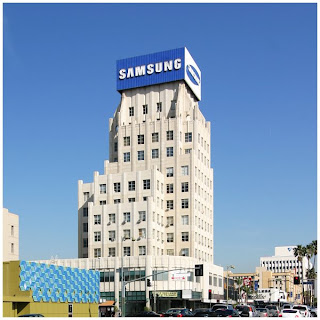 |
| Il Fungo, in the distance, center, from Via Cavalcanti |
So we took the Metro to EUR, got off at the Marconi stop and walked south on the west (right) fork of Via Cristoforo Colombo, crossing the Laghetto (little lake) and on about 1/4 mile, up a small hill to the right, to Piazza Pakistan, the site of Il Fungo.
 |
| The Fungo, c. 1960 |
 |
| Il Fungo, as it looks today |
 |
| Seattle's Space Needle (1962) |
The original restaurant, owned for a time by the tenor Mario di Monaco, closed in the late 1970s or early 1980s, and the building went into disrepair. The decline was arrested about a decade later, when a new restaurant opened and repairs and changes were made, including the repositioning of the windows, which in the original version had tilted outward from top to bottom and in the 1990 incarnation tilt inward to more easily shed rain water.
 |
| Top of the Fungo |
At least two films of significance utilize the Fungo. Michelango Antonioni's black and white drama L'Eclisse (The Eclipse) [1962], presents the Fungo as a symbol of alienation (a big theme in Italian films of that era). The film begins with Vittoria (Monica Vitti), having concluded her relationship with Riccardo, looking from an apartment to find succor in the landscape, but seeing, instead, the Fungo, a product a mechanistic modernism, even, perhaps, in its shape, symbolic of the threat of nuclear disaster.
Il Fungo appears again in Adulterio all'Italiana (Adultery Italian Style), a 1966 film starring Nino Manfredi and Catherine Spaak. This clip from YouTube includes a scene filmed at the restaurant (scroll through to about the 6-minute mark) and another, on ground level (at about 8 minutes).
 |
| Banca di Roma uses Fungo for advertising |
Although the original Fungo was not, we think, designed to support advertising (though we're not sure about that), it was inevitable that some company would want its name up there.
It's sad, but perhaps not as sad as what happened to the E. Clem Wilson building at Wilshire and La Brea in Los Angeles. Completed in 1930, the Wilson building was used as the Daily Planet on the first television production of Superman
(1951-). That building, too, fell victim to advertisers, and now sports a particularly ugly version of the Samsung name.
On a lighter note, we enjoyed our expedition to one of Rome's more unusual buildings. Although we haven't yet tried the restaurant on top, we did have beers and sandwiches at an outdoor table on the ground floor, served by a lunch place inside.
Great views looking up at Il Fungo. Thanks, M.
Bill

Title: Il Fungo: Rome's Mid-Century Modern Architecture
Rating: 100% based on 99998 ratings. 5 user reviews.
Author 1:28 AM
Rating: 100% based on 99998 ratings. 5 user reviews.
Author 1:28 AM







